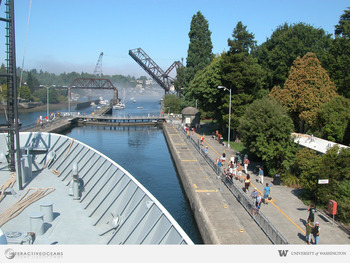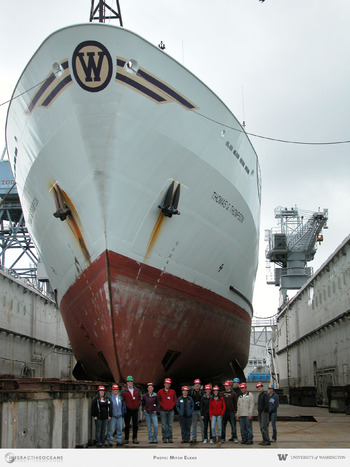Adaptation to changing circumstances
Lumens'09 was a collaborative effort between the University of Washington, Oregon State University, Arizona State University and the OOI. The UW provided ship time using the R/V Thompson, ASU provided funding for the Woods Hole Oceanographic Institution deep towed camera system, and the OOI provided funds for the autonomous vehicle Sentry. The cruise was scheduled from August 1 to August 15 with the major goal of mapping node sites from Hydrate Ridge east towards Newport Oregon, and west of Grays Harbor, Washington. A competetive application process resulted in the participation of nine UW students, three students from OSU, and a student from the College of Charleston and ASU.
This "cruise" became a learning experience centered on rapid adaptation to changing circumstances. Unfortunately, the Thompson experienced electrical, thruster and z-drive problems as we transited out of the Ballard locks. These malfunctions required us to transit down to Todd Shipyard and tie up the evening of August 1. The students and science party stayed on the ship and held daily meetings, and worked on science problems using data collected in 2008 on the INSITE08 cruise. Spirits remained high and there was hope that the required parts for the z-drive could be obtained rapidly, and that the ship could go into drydock for a quick repair. Unfortunately, this was not possible and on Thursday, August 6 the science team moved off the ship with official termination of the cruise on Wednesday. The UW team returned to campus to complete the two week intense education program. The students formed strong bonds working together on projects using high resolution bathymetry, chemical data, and digital still images of Hydrate Ridge and Axial Seamount. Of special note was a field trip to see the R/V Thompson in dry dock, providing a rare opportunity to see the under belly of the ship, propulsion systems exposed, and hull mounted sensors and water intake systems. The students continued to work hard on their projects and on August 14 they discussed their results with the team on during a series of presentations.








